
The Good Conduct Medal is one of the oldest military awards of the United States Armed Forces. The U.S. Navy's variant of the Good Conduct Medal was established in 1869, the Marine Corps version in 1896, the Coast Guard version in 1923, the Army version in 1941, and the Air Force version in 1963; the Air Force Good Conduct Medal was temporarily discontinued from February 2006 to February 2009, followed by its subsequent reinstatement.

A Reserve Good Conduct Medal refers to any one of the five military conduct awards, four of which are currently issued and one of which was previously issued, by the United States Armed Forces to members of the Reserve and National Guard. The primary difference between the regular Good Conduct Medal and the Reserve Good Conduct Medal is that the regular Good Conduct Medal is only issued for active duty service while the reserve equivalent is bestowed for reserve duties such as drills, annual training, and additional active duty for either training or operational support to the active duty force or, in the case of the Army National Guard and Air National Guard, in support of Title 32 U.S.C. state active duty (SAD) such as disaster response and relief.
The Canadian Forces' Decoration is a Canadian award bestowed upon members of the Canadian Armed Forces who have completed twelve years of military service, with certain conditions. By convention, it is also given to the governor general of Canada upon his or her appointment, which includes the title of Commander-in-Chief in and over Canada. The decoration is awarded to all ranks, who must have a good record of conduct during the final eight years of claimed service.

The Territorial Decoration (TD) was a military medal of the United Kingdom awarded for long service in the Territorial Force and its successor, the Territorial Army. This award superseded the Volunteer Officer's Decoration when the Territorial Force was formed on 1 April 1908, following the enactment of the Territorial and Reserve Forces Act 1907, which was a large reorganisation of the old Volunteer Army and the remaining units of militia and Yeomanry. However, the Militia were transferred to the Special Reserve rather than becoming part of the Territorial Force. Recipients of this award are entitled to use the letters "TD" after their name (post-nominal).

The Volunteer Officers' Decoration, post-nominal letters VD, was instituted in 1892 as an award for long and meritorious service by officers of the United Kingdom's Volunteer Force. Award of the decoration was discontinued in the United Kingdom when it was superseded by the Territorial Decoration in 1908, but it continued to be awarded in some Crown Dependencies until 1930.
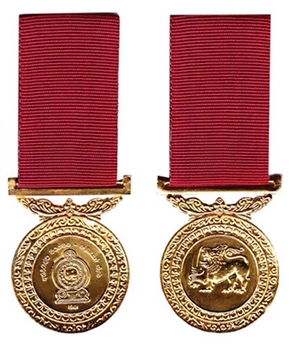
The Parama Weera Vibhushanaya (PWV) is Sri Lanka's highest military decoration, awarded for acts of exceptional valour in wartime. Parama Weera Vibhushanaya translates as the ""Decoration of Supreme Heroism", and the award is granted for "individual acts of gallantry and conspicuous bravery of the most exceptional order in the face of the enemy". Corporal Gamini Kularatne, was the first recipient. As of January 2021, the medal has been awarded 31 times, of which all were posthumous and arose from actions in the Sri Lankan Civil War. Of the 31 awardees, 28 have been from the Sri Lanka Army, two have been from the Sri Lanka Navy and one has been from the Sri Lanka Air Force.

The Emergency Reserve Decoration (ERD) was a British military decoration for long service, instituted on 17 November 1952 and given for service up to 1967.
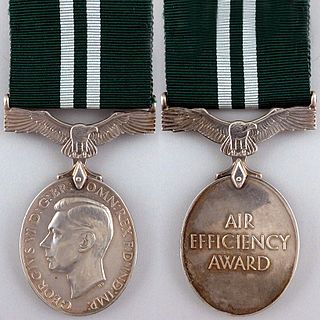
The Air Efficiency Award, post-nominal letters AE for officers, was instituted in 1942. It could be awarded after ten years of meritorious service to officers, airmen and airwomen in the Auxiliary and Volunteer Air Forces of the United Kingdom and the Territorial Air Forces and Air Force Reserves of the Dominions, the Indian Empire, Burma, the Colonies and Protectorates.
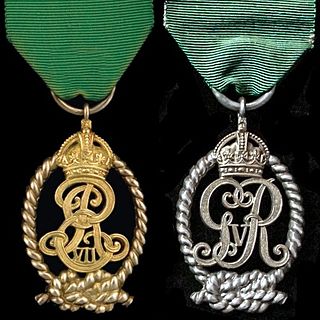
The Decoration for Officers of the Royal Naval Volunteer Reserve, post-nominal letters VD until c. 1947 and VRD thereafter, was instituted in 1908. It could be awarded to part-time commissioned officers in the United Kingdom's Royal Naval Volunteer Reserve after twenty years of service as efficient and thoroughly capable officers. The decoration was a Naval version of the Volunteer Officers' Decoration and its successor, the Territorial Decoration.

The Decoration for Officers of the Royal Naval Reserve, commonly known as the Reserve Decoration (RD) was a medal awarded to officers with at least fifteen years service in the Royal Naval Reserve (RNR) of the United Kingdom. The medal was instituted in 1908.
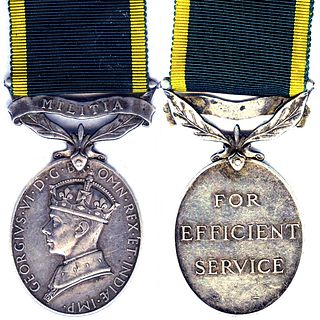
The Efficiency Medal was instituted in 1930 for award to part-time warrant officers, non-commissioned officers and men after twelve years of efficient service on the active list of the Militia or the Territorial Army of the United Kingdom, or of the other Auxiliary Military Forces throughout the British Empire. At the same time a clasp was instituted for award to holders of the medal upon completion of further periods of six years of efficient service.
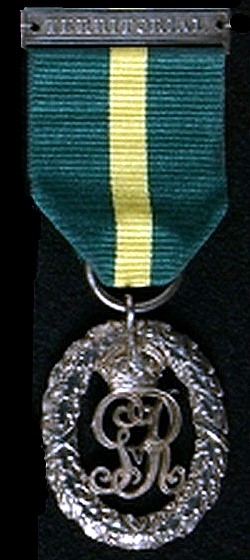
The Efficiency Decoration, post-nominal letters TD for recipients serving in the Territorial Army of the United Kingdom or ED for those serving in the Auxiliary Military Forces, was instituted in 1930 for award to part-time officers after twenty years of service as an efficient and thoroughly capable officer. The decoration superseded the Volunteer Officers' Decoration, the Colonial Auxiliary Forces Officers' Decoration and the Territorial Decoration.
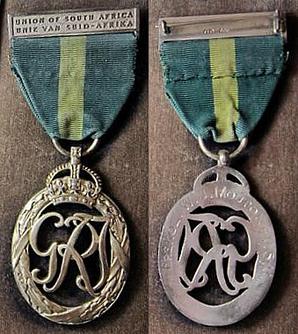
The Efficiency Decoration (South Africa), post-nominal letters ED, was instituted in 1930 for award to efficient and thoroughly capable part-time officers in the Citizen Force of the Union of South Africa after twenty years of service. The decoration superseded the Colonial Auxiliary Forces Officers' Decoration.

The Efficiency Medal (South Africa) was instituted in 1930 for award to part-time warrant officers, non-commissioned officers and men after twelve years of efficient service on the active list of the Citizen Force of the Union of South Africa. At the same time, a clasp was instituted for award to holders of the medal upon completion of further periods of six years of efficient service. The medal superseded the Colonial Auxiliary Forces Long Service Medal.
The Long Service and Good Conduct Medal is a military award recognizing 14 years of exemplary and unblemished service by non-commissioned and other ranks members of the New Zealand Defence Force. Established in 1985, these medals replaced the British Long Service and Good Conduct Medals with specific versions for New Zealand. There are three version of the Long Service and Good Conduct Medal, one each for the New Zealand Army, Royal New Zealand Navy, and the Royal New Zealand Air Force.

The Royal Naval Volunteer Reserve Long Service and Good Conduct Medal, initially designated the Royal Naval Volunteer Reserve Long Service Medal, was instituted in 1908. It could be awarded to part-time ratings in the United Kingdom's Royal Naval Volunteer Reserve after twelve years of service and good conduct. The medal was a Naval version of the Volunteer Long Service Medal and its successor, the Territorial Force Efficiency Medal.

The Volunteer Long Service Medal was instituted in 1894 as an award for long service by other ranks and some officers of the United Kingdom's Volunteer Force. Award of the medal was discontinued when it was superseded by the Territorial Force Efficiency Medal in 1908.
The Volunteer Reserves are the British Armed Forces voluntary and part-time military reserve force. Unlike the Regular Reserve, the Volunteer Reserves do not consist of ex-Regular personnel who remain liable to be re-called for military service. Instead, the Volunteer Reserves consists of civilian volunteers who routinely undergo training and military operations alongside the Regular military. The Volunteer Reserves serve under a fixed-term reserve contract and provide "highly trained" military personnel integrated with their Regular counterparts, on operations both at home and overseas. For example, almost every major military operation has seen the deployment of Army Reservists alongside the Regular British Army. Volunteer Reserves are allowed to use the post-nominal letters VR after 10 years of service.

The Royal Air Force Long Service and Good Conduct Medal is a medal awarded to regular members of the Royal Air Force in recognition of long service. It was instituted by King George V in 1919, the year following the establishment of the world's first independent air force. At first, the medal was awarded to Regular Force non-commissioned officers and airmen of the Royal Air Force. The award criteria were later relaxed to also allow the award of the medal to officers who had served a minimum period in the ranks before being commissioned. Since 2016, it is awarded to all regular members of the RAF, including officers who had never served in the ranks.

The Volunteer Officers' Decoration was instituted in 1892 as an award for long and meritorious service by officers of the United Kingdom's Volunteer Force. In 1894, the grant of the decoration was extended to commissioned officers of Volunteer Forces throughout the British Empire. A separate new decoration was instituted, the Volunteer Officers' Decoration for India and the Colonies, post-nominal letters VD.

















